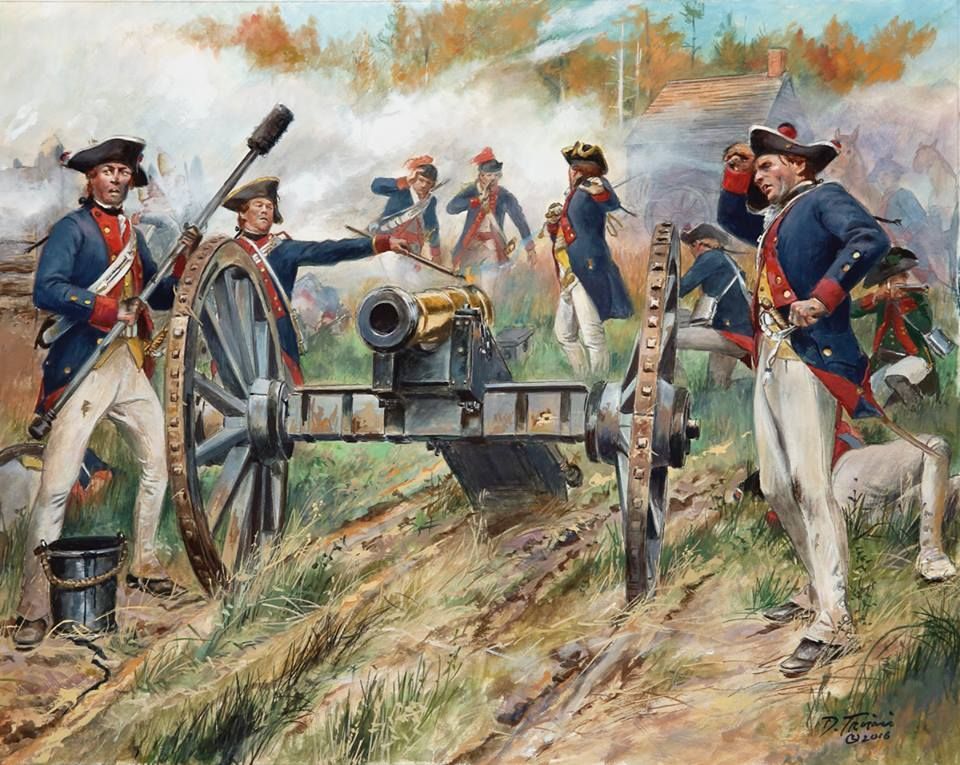This Oak Tree Cache is located in the woods where the Americans and British battled in 1777.
On the night of June 25, 1777 2,000 Americans soldiers under the command of Lord Stirling were camped in the Short Hills near the Ash Swamp Metuchen Meeting House, they were unaware that the British Army was getting ready to march toward them. By dawn on the 26th, 18,000 British/Hessian troops marched in two columns from Perth Amboy with the goal of surrounding George Washington, and the American Army at Quibbletown, (Clark).
In Piscataway one British column under the command of Lord Cornwallis moved through Woodbridge to what is now Oak Tree Rd. The other column under the command of General Vaughan, with General Howe, moved toward the Metuchen Meeting House. The only thing standing in the British troops way were the 2,000 Americans under the command of General Stirling camped at the Short Hills.
 ”Battle of Oak Tree"
”Battle of Oak Tree"
Around 6 a.m. elements of American Colonel Daniel Mogan’s riflemen encountered the British troops of Lord Cornwallis on what is now Green St. in Wood- bridge. Cornwallis continued to move west on Oak Tree Rd. and engaged General Thomas Conway’s Brigade which retreated toward the Short Hills
Cornwallis then marched to the corner of Oak Tree and New Dover Roads, where he attacked Ottendorf’s Corp. At this point of the Battle of the Short Hills American General Lord Stirling advanced with “Scotch Willie” Maxwell’s NJ Brigade, and the main action began.
The Americans and British battled the next hour and a half as the soldiers maneuvered, fought, and died in the area between Oak Tree Rd. Woodland Ave. Tingley Lane, extending up into Scotch Plains, retreating into the safety of the Watchung Mountains, through the "Bloody Gap"
 ”Battle of Oak Tree with French Cannons"
”Battle of Oak Tree with French Cannons"
Oak Tree Battle Facts:
Congress adopted the “Stars & Stripes as the American flag on June 14th, the battle was on the 26th, making this the first defense of the American flag.
The battle was the first use of French cannons by the Americans during the war.
During the battle, the Americans lost, recaptured, and lost again the 3 French cannons.
British Captain, John Finch was mortally wounded after shouting at Lord Stirling “Come here you damned rebel and I will do for you”. At the end of the Battle some American units withdrew toward Quibbletown, and others toward Scotch Plains and Westfield.
The British left column under Vaughan marched from Metuchen Meeting House, and reached Oak Tree Rd. too late to be part of the battle.
A tactical field victory by the British, they did not accomplish their goal of surrounding and destroying the American Army
American casualties were around 200 men, while the British losses ranged between 70 to 130 men
Washington observed the battle from the Watchung Mountains, at what is now known as Washington Rock.
Notable American Soldiers included Major Richard Howell, future 2nd Governor of NJ. Two sons of signers of the Declaration of Independence, Capt. Thomas Clark, & Brigade Major James Witherspoon. Future youngest signer of the Constitution, Captain Jonathan Dayton.
 ”route of battle and retreat"
”route of battle and retreat"
This cache is one of "The American Revolution Geo~Trail" caches throughout New Jersey. These special geocaches are hidden at many historic locations which have a connection to important New Jersey's American Revolutionary War history. To participate in the optional Geo-Trail, after you find the geocache, locate the secret code and record it into your passport which you will print from this website. Information at njpatriots.org
 ”njpatriots.org"
”njpatriots.org"
The Northern New Jersey Cachers, NNJC is about promoting a quality caching experience in Northern New Jersey. For information on The Northern New Jersey Cachers group you can visit: www.nnjc.org.
 nnjc.org & metrogathering.org, & njpatriots.org
nnjc.org & metrogathering.org, & njpatriots.org